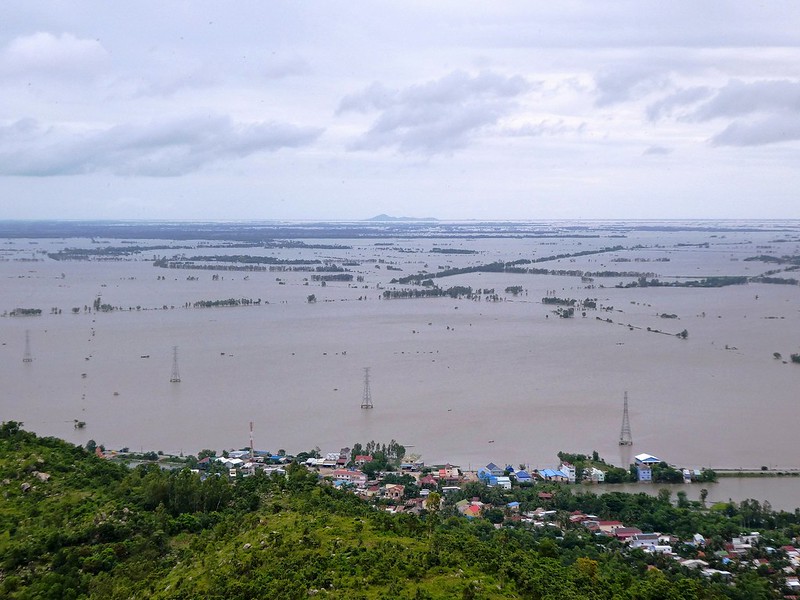នៅខែតុលា ឆ្នាំ២០២០ ព្យុះត្រូពិកដែលមានឈ្មោះថា LINFA និង NANGKA បានវាយប្រហារប្រទេសវៀតណាម កម្ពុជា ឡាវនិង ថៃ។ ព្យុះនេះបណ្តាលឱ្យមានមនុស្សយ៉ាងតិច ៤៨ នាក់បានស្លាប់, មនុស្ស ១៥ នាក់ទៀតបានបាត់ខ្លួន និងប្រជាជនជាង ៨៣០,៤០០ នាក់បានរងផលប៉ះពាល់ នេះបើយោងតាមការរាយការណ៍ពីមជ្ឈមណ្ឌលសម្របសម្រួលអាស៊ានសម្រាប់ជំនួយមនុស្សធម៌ស្តីពីការគ្រប់គ្រងគ្រោះមហន្តរាយ (AHA)។1
នៅប្រទេសកម្ពុជាអ្នកស្លាប់មានចំនួន ១១ នាក់ ហើយខណៈដែល ៦៧.៩៩៥ គ្រួសារនៅក្នុងខេត្តចំនួន ១៩ បានរងគ្រោះដោយសារទឹកជំនន់ទឹកភ្លៀង។ ខេត្តដែលរងគ្រោះខ្លាំងជាងគេរួមមានខេត្តបាត់ដំបង (៣៨.៨៩០ គ្រួសារ) ខេត្តពោធិ៍សាត់ (១៨.៣៦៥ គ្រួសារ) និងខេត្តបន្ទាយមានជ័យ (៧.០៣៤ គ្រួសារ)។2 នៅពាក់កណ្តាលខែតុលា ទឹកជំនន់ទឹកភ្លៀងបណ្តាលមកពីព្យុះបានបង្ខំឱ្យមានការជម្លៀសមនុស្ស ២៥.១៩២ នាក់ នេះបើយោងតាមគណៈកម្មាធិការជាតិគ្រប់គ្រងគ្រោះមហន្តរាយ។3 កាកបាទក្រហមរបស់ប្រទេសសិង្ហបុរីនឹងត្រៀមថវិកាសរុបចំនួន ៧៥.០០០ ដុល្លារសម្រាប់ជំនួយសង្គ្រោះ និងប្រតិបត្តិការសង្គ្រោះគ្រោះមហន្តរាយដល់កាកបាទក្រហមកម្ពុជា កាកបាទក្រហមឡាវ និងកាកបាទក្រហមវៀតណាម (២៥.០០០ ដុល្លារអាមេរិកក្នុងមួយប្រទេស)។4 ជំនួយមនុស្សធម៌ចំនួន ១០០,០០០ ដុល្លារអាមេរិកកំពុងត្រូវបានផ្តល់ឱ្យតាមរយៈទីភ្នាក់ងារសហរដ្ឋអាមេរិកសម្រាប់ការអភិវឌ្ឍន៍អន្តរជាតិ (USAID)។5
ផែនទីបង្ហាញពីសន្ទស្សន៍ហានិភ័យ INFORM នៅបណ្តាប្រទេសតំបន់មេគង្គក្រោម ឆ្នាំ ២០២០
ប្រភព: INFORM risk index. ផែនទីផលិតដោយ អង្គការទិន្នន័យអំពីការអភិវឌ្ឍ ខែតុលា ឆ្នាំ ២០២០។ ក្រោមអាជ្ញាបណ្ណ CC-BY-SA 4.0។
ប្រទេសកម្ពុជាគឺជាប្រទេសមួយក្នុងចំណោមប្រទេសអាស៊ីដែលត្រូវបានគេចាត់ទុកថាជាប្រទេសងាយរងគ្រោះមហន្តរាយ។ គ្រោះមហន្តរាយធម្មជាតិដែលកើតឡើងជាទូទៅ រួមមានទឹកជំនន់ គ្រោះរាំងស្ងួត និងខ្យល់ព្យុះ/ព្យុះទីហ្វុង។ ប្រទេសកម្ពុជាមានចំណាត់ថ្នាក់ហានិភ័យកម្រិតមធ្យមនៅលើសន្ទស្សន៍ហានិភ័យ INFORM ឆ្នាំ ២០២០ ប៉ុន្តែប្រទេសនេះទទួលបានពិន្ទុខ្ពស់លើសូចនាករដោយឡែកមួយចំនួន ដូចជាភាពងាយរងគ្រោះ និងកង្វះសមត្ថភាពក្នុងការដោះស្រាយទៅនឹងគ្រោះមហន្តរាយ។ កម្ពុជាទទួលបានពិន្ទុ ៦,២ លើ ១០ សម្រាប់ភាពងាយរងគ្រោះដោយសារភាពខ្វះខាត និងការអភិវឌ្ឍមិនបានគ្រប់គ្រាន់។6
ការប្រែប្រួលអាកាសធាតុ គួបផ្សំនឹងការអភិវឌ្ឍទីក្រុងបានបណា្តលឱ្យមានការកើនឡើងនូវគ្រោះទឹកជំនន់។ ម្យ៉ាងវិញទៀត ការធ្វើនគរូបនីយកម្មដែលមិនបានគ្រោងទុក ក៏កំពុងរួមចំណែកដល់ការកើនឡើងនៃការប៉ះពាល់ផងដែរ។ អ្នកតាំងទីលំនៅក្រៅផ្លូវការប្រមាណជា ២៥០,០០០ នាក់រស់នៅក្នុងរាជធានីភ្នំពេញ ដែលជាទីក្រុងមានប្រជាជនប្រមាណ ១,៦ លាននាក់។7 ការកើនឡើងនូវការប្រឈមទៅនឹងគ្រោះមហន្តរាយ ជាញឹកញាប់មានទំនាក់ទំនងជាមួយនឹងកង្វះហេដ្ឋារចនាសម្ព័ន្ធ ការតាំងទីលំនៅក្រៅផ្លូវការនៅតាមតំបន់ទំនាប និងមាត់ទន្លេដែលងាយរងគ្រោះដោយទឹកជំនន់ និងប្រព័ន្ធជម្លៀសទឹកមិនគ្រប់គ្រាន់។ ការបណ្តេញចេញពីទីលំនៅតែងតែជាហេតុផលដោយសារកង្វះកម្មសិទ្ធិស្របច្បាប់ ហើយលំនៅដ្ឋានដែលមានគុណភាពអន់ជាច្រើនមិនមានភាពធន់ទ្រាំនឹងអាកាសធាតុ។8

ទឹកជំនន់មេគង្គនៅប្រទេសកម្ពុជា។ រូបភាព ដោយ Jean-Philippe Venot ថតនៅថ្ងៃទី១៧ ខែកញ្ញា ឆ្នាំ២០១៨។ ក្រោមអាជ្ញាបណ្ណ CC BY-NC 2.0.
ការប្រែប្រួលអាកាសធាតុកំពុងគំរាមកំហែងដល់ការអភិវឌ្ឍប្រទេសកម្ពុជា និងរួមចំណែកដល់ការកើនឡើងនូវគ្រោះមហន្តរាយ ទោះបីជារដ្ឋាភិបាលខិតខំប្រឹងប្រែងក្នុងការបញ្ជ្រាបការការពារបរិស្ថាន និងការបន្ស៊ាំទៅនឹងអាកាសធាតុក៏ដោយ។ ការព្យាករនាពេលអនាគតបង្ហាញពីការកើនឡើងនៃទឹកភ្លៀងប្រចាំឆ្នាំ ប៉ុន្តែក៏មានការថយចុះនៃរបបទឹកភ្លៀងនៅតំបន់ភាគឦសាននៃប្រទេសផងដែរ។ តំបន់ឆ្នេរសមុទ្រត្រូវបានគេរំពឹងថានឹងទទួលរងនូវការជន់លិចបន្ថែមទៀតក្នុងរយៈពេល ៩០ ឆ្នាំខាងមុខ ដោយសារការកើនឡើងនៃកម្ពស់ទឹកសមុទ្រ។9 ផ្ទៃដីដាំដុះនៅតំបន់ទំនាបមិនត្រឹមតែប្រឈមនឹងការកើនឡើងនូវទឹកជំនន់ប៉ុណ្ណោះទេ ប៉ុន្តែថែមទាំងការឈ្លានពានដោយទឹកប្រៃ ខណៈការថយចុះទិន្នផលស្រូវ ១០ ភាគរយត្រូវបានប៉ាន់ស្មាននូវរាល់ការកើនឡើងសីតុណ្ហភាព ១ អង្សាសេ ដែលប្រការបង្ហាញថាការប្រែប្រួលអាកាសធាតុគឺជាការគំរាមកំហែងយ៉ាងធ្ងន់ធ្ងរដល់សន្តិសុខ និងសុវត្ថិភាពស្បៀង។10
ស្ទើរតែរៀងរាល់ឆ្នាំចាប់តាំងពីឆ្នាំ ២០០០ មានទឹកជំនន់ដែលបណ្តាលឱ្យមានមនុស្សស្លាប់យ៉ាងតិច ៥ នាក់។11
| ឆ្នាំ | ចំនួនទឹកជំនន់ដែលបណ្តាលឱ្យមានមនុស្សស្លាប់ច្រើនជាង ៥ នាក់ (ជំនន់ធំ) | ចំនួនអ្នកស្លាប់ដោយសារទឹកជំនន់ធំ | ចំនួនផ្ទះខូចខាតឬបំផ្លាញដោយព្យុះខ្លាំង |
១៩៩៦ | ៦ | ១៥៥ | ២៦២៩ |
២០០០ | ១៤ | ២៥២ | ១៨៩៩ |
២០០១ | ១ | ៥ | ០ |
២០០២ | ១ | ៩ | ២ |
២០០៣ | ១ | ៧ | ០ |
២០០៥ | ១ | ៦៤ | ១០៣៥ |
២០០៩ | ២ | ១៣ | ១ |
២០១១ | ៩ | ៦៨ | ១១៧ |
២០១២ | ១ | ៦ | ០ |
២០១៣ | ២ | ១៦ | ០ |
២០១៤ | ១ | ១២ | ១២៤ |
២០១៧ | ១ | ៨ | ១៣៧ |
២០១៨ | ៣ | ៤១ | ១៥៤ |
២០១៩ | ៣ | ១៦ | ៨២ |
ចំនួនសរុប | ៤៦ | ១៥៥ | ៦១៨០ |
ប្រធានបទពាក់ព័ន្ធនឹងទឹកជំនន់៖
ឯកសារយោង
- 1. ការិយាល័យអង្គការសហប្រជាជាតិសំរាប់ការសម្របសម្រួលកិច្ចការមនុស្សធម៌ (OCHA) «ប្រទេសកម្ពុជា វៀតណាម ឡាវ ថៃ – សកម្មភាពពាក់ព័ន្ធនឹងអាកាសធាតុ និងព្យុះស៊ីក្លូនធ្ងន់ធ្ងរ (DG ECHO, GDACS, AHA Center, DBQG, Cambodia Meteo, NOAA-CPC) (ការតាមដានពីអាកាសធាតុប្រចាំនៅថ្ងៃទី ១៥ តុលា ២០២)» ថ្ងៃទី១៥ ខែតុលា ឆ្នាំ២០២០។ ចូលអាននៅថ្ងៃទី ២១ ខែតុលា ឆ្នាំ២០២០។
- 2. ដូចឯកសារយោងខាងដើម។
- 3. ការិយាល័យអង្គការសហប្រជាជាតិសំរាប់ការសម្របសម្រួលកិច្ចការមនុស្សធម៌ (OCHA) «ទីភ្នាក់ងារជំនួយសហរដ្ឋអាមេរិក USAID ផ្តល់ជំនួយភ្លាមៗក្នុងការឆ្លើយតបទៅនឹងទឹកជំនន់កើតឡើងនៅប្រទេសវៀតណាម និងប្រទេសកម្ពុជា» ថ្ងៃទី២១ ខែតុលា ឆ្នាំ២០២០។ ចូលអាននៅថ្ងៃទី២១ ខែតុលា ឆ្នាំ២០២០។
- 4. ការិយាល័យអង្គការសហប្រជាជាតិសំរាប់ការសម្របសម្រួលកិច្ចការមនុស្សធម៌ (OCHA) «កាកបាទក្រហមប្រទេសសឹង្ហបូរីគាំទ្រសហគមន៍រងគ្រោះដោយទឹកជំនន់នៅកម្ពុជា ឡាវ និងវៀតណាម» ថ្ងៃទី២១ ខែតុលា ឆ្នាំ២០២០។ ចូលអាននៅថ្ងៃទី២១ ខែតុលា ឆ្នាំ២០២០។
- 5. ស្ថានទូតសហរដ្ឋអាមេរិក «រដ្ឋាភិបាលសហរដ្ឋអាមេរិកផ្តល់ជំនួយបន្ទាន់ក្នុងការឆ្លើយតបទៅនឹងគ្រោះទឹកជំនន់ដែលរីករាលដាលនៅកម្ពុជា» ថ្ងៃទី១៧ ខែតុលា ឆ្នាំ២០២០។ ចូលអាននៅថ្ងៃទី១៧ ខែតុលា ឆ្នាំ២០២០។
- 6. មជ្ឈមណ្ឌលចំណេះដឹងអំពីការគ្រប់គ្រងហានិភ័យនៃគ្រោះមហន្តរាយ (គណៈកម្មការអឺរ៉ុប) «សន្ទស្សន៍ហានិភ័យ INFORM សម្រាប់ស្ថានភាពនៃប្រទេសនីមួយ» ឆ្នាំ ២០២០។ ចូលអាននៅថ្ងៃទី១៥ ខែតុលា ឆ្នាំ២០២០។
- 7. Benjamin Flower និង អ្នកនិពន្ធផ្សេងទៀត «ការប្រើវិធីសាស្ត្រការចូលរួមដើម្បីបង្ហាញពីអន្តរកម្មហានិភ័យក្នុងទីក្រុង ករណីសិក្សាអំពីការតាំងទីលំនៅក្រៅផ្លូវការចំនួន ៣ ទីតាំងនៅក្នុងរាជធានីភ្នំពេញនៃប្រទេសកម្ពុជា៖ បរិស្ថាន និងនគរូបនីយកម្ម» ឆ្នាំ ២០១៧។ ចូលអាននៅថ្ងៃទី ១៥ ខែតុលាឆ្នាំ ២០២០។
- 8. ដូចឯកសារយោងខាងដើម។
- 9. ក្រសួងបរិស្ថាន «ផែនការសកម្មភាពឆ្លើយតបនឹងការប្រែប្រួលអាកាសធាតុឆ្នាំ ២០១៦-២០១៨» ឆ្នាំ ២០១៦។ ចូលអាននៅថ្ងៃទី១៥ ខែតុលា ឆ្នាំ២០២០។
- 10. រាជរដ្ឋាភិបាលកម្ពុជា «ផែនការយុទ្ធសាស្ត្រឆ្លើយតបនឹងការប្រែប្រួលអាកាសធាតុកម្ពុជា ២០១៤-២០២៣» ឆ្នាំ ២០១៣។ ចូលអាននៅថ្ងៃទី១៥ ខែតុលា ឆ្នាំ២០២០។
- 11. គណៈកម្មាធិការជាតិគ្រប់គ្រងគ្រោះមហន្តរាយ «ប្រព័ន្ធព័ត៌មានស្តីអំពីការខូចខាត និងការប៉ះពាល់គ្រោះមហន្តរាយនៅកម្ពុជា (CamDi)» ឆ្នាំ២០២០។ ចូលអាននៅថ្ងៃទី១៥ ខែតុលា ឆ្នាំ២០២០។

